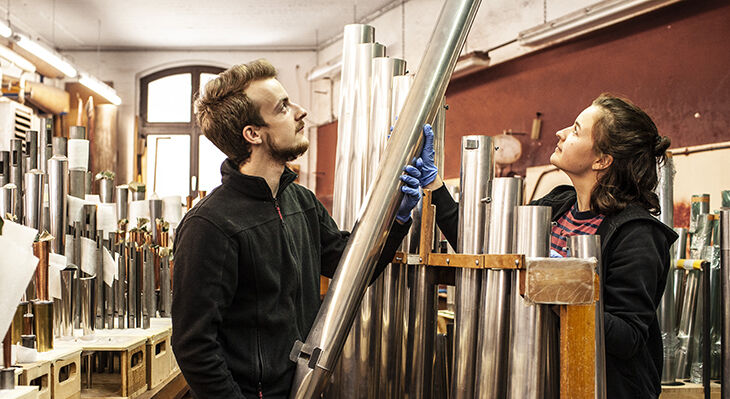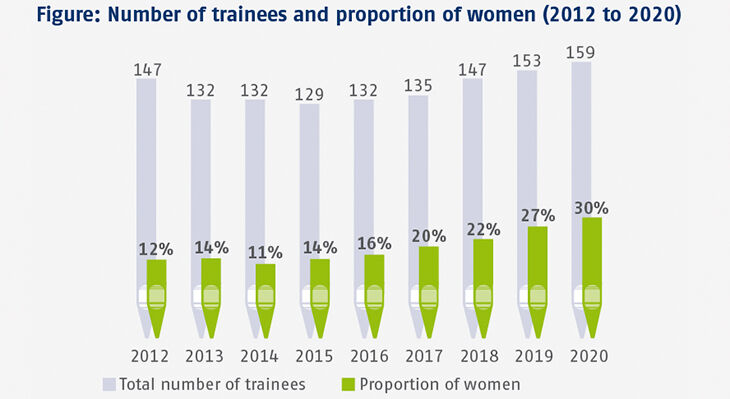Profile of an occupation – organ builder
No two organs are the same since each one is individually made for the architectural space in which it is intended to ring out. Organ builders are specialists in a trade which builds on centuries of experience and combines traditional craft techniques with the latest technologies. Organ builder is clearly one of the musical instrument-making training occupations which attracts considerable interest. In a survey conducted by our BWP newsletter, a clear majority said they wished to learn more about this occupation.

Instrument and organ making in Germany
Germany is home to well over 1,000 traditionally operating craft trade and industrial companies which specialise in the construction, repair or tuning of various types of musical instrument. Most of these firms concentrate on the manufacture of pianos, stringed and plucked instruments, wooden and metal wind instruments and percussion instruments. Organ building plays a particular role. No other instrument requires such complex interplay between countless components.
One example is the organ at the Elbphilharmonie in Hamburg, which has 69 stops and 4,765 pipes. It measures 15 metres by 15 metres and weighs approximately 25 tonnes. Germany has around 50 major organ building companies employing between ten and 60 staff.
The highly specialised knowledge and particular skills needed for organ building have been developed over centuries. Organ culture is a traditional form of culture with an important basis in Germany. The significance of organ building in the country was acknowledged by its inclusion in the UNESCO Convention for the Safeguarding of Intangible Cultural Heritage in 2017. According to UNESCO, Germany’s 50,000 organs constitute the highest concentration of the instruments in the world.
Special term – windchest
Organ builders refer to moving air as wind. Windchests are the central switching and control stations of an organ. They distribute the wind coming from the bellows on the basis of information received from the console. A windchest contains many valves which either block the wind moving through the organ or else permit it to pass to the pipes so that the sounds can ring out.
Multifarious knowledge and a high degree of mobility readiness
Training is divided into the two specialisms of “organ building” and “pipe building”, and the differentiation is made after the first 18 months of a programme which is three and a half years long in total. Vocational school teaching takes place in scheduled blocks at a single location in Ludwigsburg. The processing of wood, metals, plastics and other materials such as leather and felt, both manually and by machine, is a major part of organ building. All organ builders learn how to manufacture a wide range of organ pipes from wood and metal. More detailed knowledge is imparted in the specialism of “pipe building”. In the specialism of “organ building”, trainees also become familiar with the manufacture of consoles (complete with keyboards and stops), housings, and electrical and electronic components. All trainees learn how to tune and intone the organ pipes and are able to differentiate between the different structural forms and functionalities of organs.
There is international demand for the manifold knowledge and skills of organ builders. German organs are spread all over the world, and site visits need to be paid for repairs or maintenance works. For this reason, organ builders are used to frequent changes of location. Even whilst still training, they often travel for several days to places where new organs are being assembled. Intercultural skills and knowledge of foreign languages are therefore important in in this occupation. When organs are constructed abroad, organ builders will recruit local staff to the team who will subsequently also be responsible for the future maintenance and care of the instrument.
Almost a third of organ builders are women
There was very little change in the number of trainee organ builders during the period from 2012 (147) to 2020 (159). This is, however, a training occupation enjoying increasingly popularity amongst young women. The proportion of female trainees rose from only 12 percent in 2012 to 30 percent in 2020 (see Figure).

A combination of traditional and modern technologies
Organ building has always been a symbiosis of traditional craft trade knowledge and the contemporary and cultural history of the age in question. Organ builders build long-lasting musical instruments using traditional craft trade techniques. On the other hand, the sector is continually shifting, opening up and adjusting to new developments and listening habits. An organ’s technical innovations are frequently not even visible to outsiders. The action of organs, i.e. the link between the keys and the pipe valves, has, for example constantly been adapted to technical developments. The move has been made from mechanical to pneumatic systems all the way to electrically operated versions. Even IT network technology has begun to be included in organ building. Digital technologies, which may involve everything from 3D printers for the manufacture of small replacement parts to digital planning and measurement tools, provide organisational and construction assistance on site when the architectural situation is being determined.
At a glance
- Last updated: 2019
- Duration of training: 3.5 years
- Responsibility: Trade and industry
- Training structure: Training occupation with two specialisms
- Organ building
- Pipe building
- DQR reference level: 4
- Advanced vocational training: master organ and harmonium maker
Further links
BIBB website page on the occupation (in German)
Podcast on the profile of the occupation featuring two trainees (in German)
All links: last updated 12/10/2022
(Compiled by Arne Schambeck)
Sources: German UNESCO Commission, German Music Information Centre (miz)
Translation from the German original (published in BWP 4/2022): Martin Kelsey, GlobalSprachTeam, Berlin